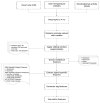Assessing Physiological Stress Responses in Student Nurses Using Mixed Reality Training
- PMID: 40432013
- PMCID: PMC12115781
- DOI: 10.3390/s25103222
Assessing Physiological Stress Responses in Student Nurses Using Mixed Reality Training
Abstract
This study explores nursing students' stress responses while they are being trained in a mixed reality (MR) setting that replicates highly stressful clinical scenarios. Using measurements of physiological indices such as heart rate, electrodermal activity, and skin temperature, the study assesses the level of stress when the students interact with digital patients whose vital signs and symptoms interact dynamically to respond to student inputs. The simulation consists of six segments, during which critical events like hypotension and hypoxia occur, and the patient's condition changes based on the nurse's clinical decisions. Machine learning algorithms were then used to analyze the nurse's physiological data and to classify different levels of stress. Among the models tested, the Stacking Classifier demonstrated the highest classification accuracy of 96.4%, outperforming both Random Forest (96.18%) and Gradient Boosting (95.35%). The results showed clear patterns of stress during the simulation segments. Statistical analysis also found significant differences in stress responses and identified key physiological markers linked to each stress level. This pioneering study demonstrates the effectiveness of MR as a training tool for healthcare professionals in high-pressured scenarios and lays the groundwork for further studies on stress management, adaptive training procedures, and real-time detection and intervention in MR-based nursing training.
Keywords: mixed reality; nursing; physiological measures analysis; wearable sensors.
Conflict of interest statement
The authors declare no conflicts of interest.
Figures









Similar articles
-
Exploring the Correlation of Physiological Stress Signals with Student Exam Performance: A Preliminary Study.Appl Psychophysiol Biofeedback. 2025 Mar;50(1):149-164. doi: 10.1007/s10484-025-09685-2. Epub 2025 Jan 17. Appl Psychophysiol Biofeedback. 2025. PMID: 39821509 Free PMC article.
-
Psychophysiological Stress Indicators of Heart Rate Variability and Electrodermal Activity With Application in Healthcare Simulation Research.Simul Healthc. 2020 Feb;15(1):39-45. doi: 10.1097/SIH.0000000000000402. Simul Healthc. 2020. PMID: 32028446
-
Continuous Stress Detection Using Wearable Sensors in Real Life: Algorithmic Programming Contest Case Study.Sensors (Basel). 2019 Apr 18;19(8):1849. doi: 10.3390/s19081849. Sensors (Basel). 2019. PMID: 31003456 Free PMC article.
-
Technology Assessment: Early Sense for Monitoring Vital Signs in Hospitalized Patients [Internet].Washington (DC): Department of Veterans Affairs (US); 2016 May. Washington (DC): Department of Veterans Affairs (US); 2016 May. PMID: 27606394 Free Books & Documents. Review.
-
Into the Wild: The Challenges of Physiological Stress Detection in Laboratory and Ambulatory Settings.IEEE J Biomed Health Inform. 2019 Mar;23(2):463-473. doi: 10.1109/JBHI.2018.2883751. Epub 2018 Nov 28. IEEE J Biomed Health Inform. 2019. PMID: 30507517 Review.
References
-
- Kibria M.G. Prevalence of Stress and Coping Mechanism Among Staff Nurses of Intensive Care Unit in a Selected Hospital. Int. J. Neurosurg. 2018;2:8. doi: 10.11648/j.ijn.20180201.12. - DOI
-
- Kundrata D., Pukljak Z., Repustić M., Rotim C., Friganović A., Kurtović B. Coping with stress of nurses employed in the internal medicine and surgical departments. Croat. Nurs. J. 2022;6:33–43. doi: 10.24141/2/6/1/3. - DOI
MeSH terms
Grants and funding
LinkOut - more resources
Full Text Sources
Medical

